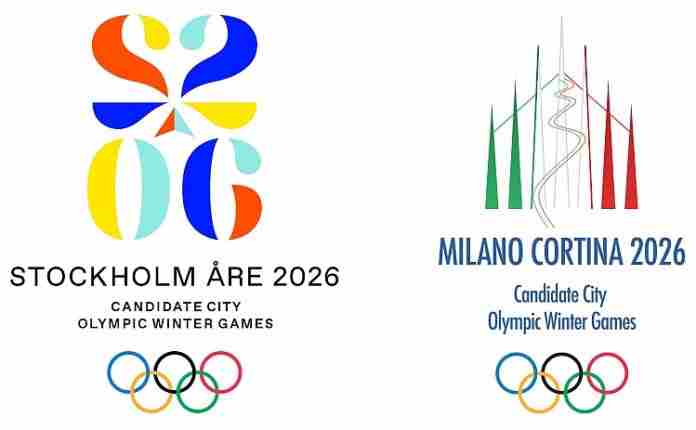The International Olympic Committee’s Evaluation Commission released its report on the two candidates for the 2026 Olympic Winter Games, with considerably excitement over the Milan-Cortina bid and not so much for Stockhom-Are.
The 144-page report profiled each bid in specific areas including Games Concept, Games Experience, Paralympic Games and Games Delivery. There was no numeric scoring – and thus no direct comparison – between the two bids, but the preference for the Italian offer was clear in section after section:
● Games Concept
The normal lofty rhetoric was present for both bids, but the Milan-Cortina concept had two exceptional drivers that can actually happen:
“Goal 2: Sustainable development and cooperation in the macro-alpine region”
“Goal 4: Development of Italy’s Alpine and Dolomites region into a major sports and tourism hub”
The report further noted – approvingly – of the integration of the Games concept into the development goals of the northern Italian regions where the events would be held:
“(1) Games can enhance the attractiveness of the mountain region as a place to live and work, to reverse the trend of de-population (including improved physical and digital infrastructure)
“(2) Olympic Village development aligns well with Milan’s need to meet growing demand for affordable university accommodation.”
These are crucial elements to making an Olympic Games “fit” into a region rather than changing the region to meet the needs of a Games.
Milan’s venue plan has 14 competition sites, with six existing, four existing that need work, three temporary and only one to be built, and which will be built regardless of whether the Games are awarded. The only yellow card was for the renovation plan of the 1956 Cortina sliding venue; although the regional government wants to fix it – it’s been closed since 2008 – the Evaluation Commission suggested these sports could be held in an existing facility else and save a lot of money. For example, the track at St. Moritz (SUI) is less than 200 km distant to the north.
The Stockholm-Are concept has the typical goal of “Encourage more physical activity and sports participation to promote a healthy lifestyle among Swedish youth,” but does not tie in with the long-term plans for the Stockholm region in any significant way.
The Stockholm-Are venue concept obviously troubled the Evaluation Commission: six of the 12 proposed sites are existing, two exist but need work, one is temporary and three need to be built. A new Cross Country and Biathlon facility at Hamra is proposed, but excellent existing venues at Falun and Oestersund are already available and “Games-ready.” Moreover, that facility, a planned Speed Skating venue at Barkarby and the Stockholm-area village are all to be privately developed and no back-up plans were submitted. The post-Games operating funding for the skating oval is expected to come mostly from public sources, but this is not confirmed.
The sliding sports would be held in Sigulda (LAT), across the Baltic Sea, which is an established World Cup site for bobsleigh and luge.
● Games Experience
Milan proposes six Olympic Villages to keep the athletes close to their competition venues. The Milan village will be built to support the growing need for university housing for students in the area and if not built by private developers, will be underwritten by the Lombardy region.
Stockholm-Are has four housing centers; in addition to the privately-built Stockholm village, the housing in Are is also a new development to be built by the resort owner with private financing. The Evaluation Commission also saw significant risk in this. Further, almost all of the accommodations in Falun (Nordic Combined and Ski Jumping) and Are (Alpine Skiing, Freestyle & Snowboard) will be needed for athletes, officials and media, leaving very little for spectators.
● Paralympic Games
Milan-Cortina’s proposal is to use the existing Olympic sites for the Paralympics, with three venue clusters. The Evaluation Commission suggested simplifying the plan to two clusters to save costs. The regional governments have committed to $62 million in subsidies to support the Paralympics.
Stockholm-Are has the six sports in two clusters; the usual questions about accessibility at the to-be-built accommodations in Stockholm and Are were raised. No government support for the Paralympics was noted.
● Games Delivery
There’s no doubt that Sweden, an established winter-sports power, can stage excellent Winter Games. But in comparing the reports on the two bids, there is an obvious edge for Milan-Cortina.
In hotel room availability, Milan-Cortina shows 71,000 existing; Stockholm-Are has existing inventory of about 50,100.
The budget for Milan-Cortina – in 2018 dollars – is strikingly low at $1.57 billion, but is balanced with a 9% contingency ($142.4 million), in a country with the eighth-largest economy in the world and a developed commercial sponsorship sector.
The Evaluation Commission was obviously dismayed by Stockholm-Are’s budget. At $1.52 billion, it used the 2026 numbers (not discounted to 2018) for IOC support subsidies and $100 million more from the IOC’s sponsorship program that has been committed to. Conclusions: “If [IOC contribution was] discounted, this would create a significant gap in the 2018 USD budget” and “Scale of the Swedish economy and market may prove to be a limiting factor in revenue generation.”
The Milan-Cortina bid has enthusiastic support of both municipal councils and both will sign the Host City Contract. The regional governments of Lombardy (Milan) and Veneto (Cortina) are both deeply involved.
For Stockholm-Are, neither the city of Stockholm or City of Are are proposed as signers of the Host City Contract. The Swedish government has agreed to provide security and customs services.
The kicker is the vast difference in public support. The IOC’s own polling in February 2019 showed support for the candidature at 83-4% in favor in Italy and 87-4% in Milan. It’s much difference for Stockholm-Are: just 55-17% (28 no opinion) in Sweden and 54-17% (30% no opinion) in Stockholm.
The Evaluation Commission’s report is written with great precision, and while intentionally bland in some areas, clearly favors Milan-Cortina as a better bet for the IOC. The venue plan, the infrastructure support, the budget and most of all the interest of the public clearly make the Italian site the preferred selection.
What will the IOC membership do? That’s yet to be seen, but the report does a good job of making clear the strengths and shortcomings of each bid, based on the admittedly-limited information available right now.
In a month, we’ll see how many IOC members actually took the time to read the Evaluation Commission’s report.


























